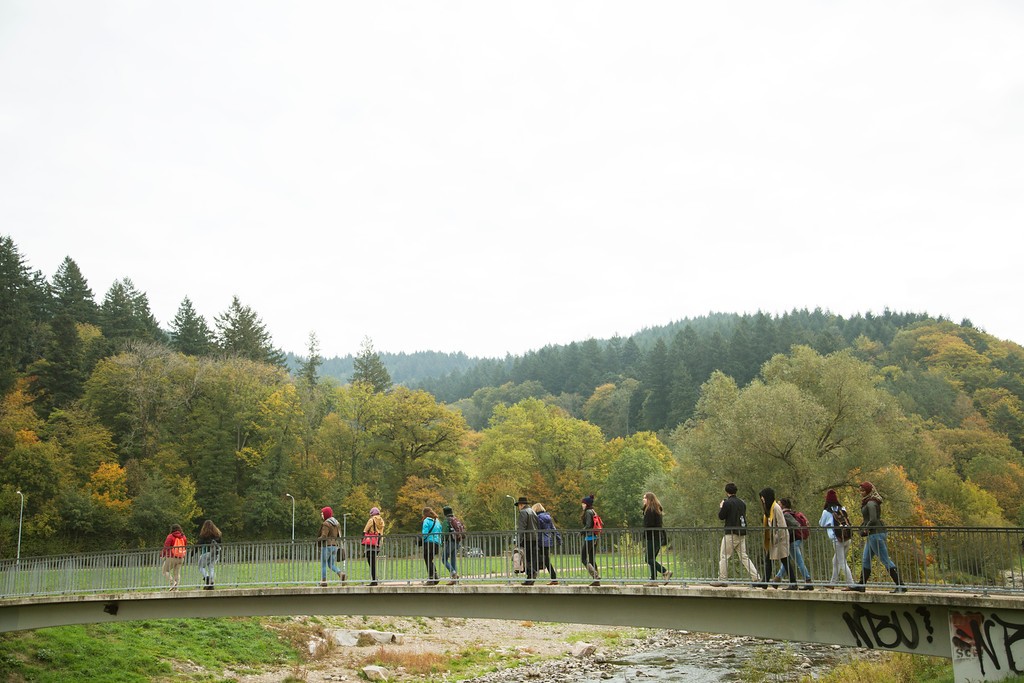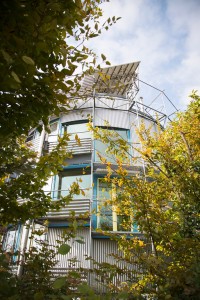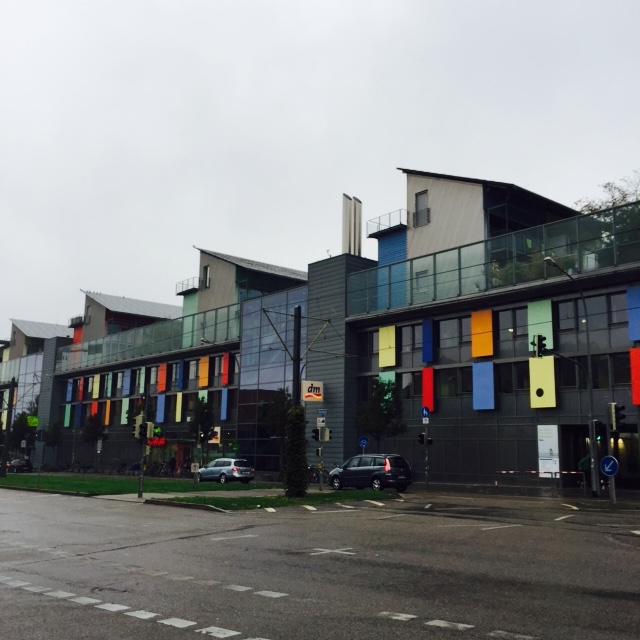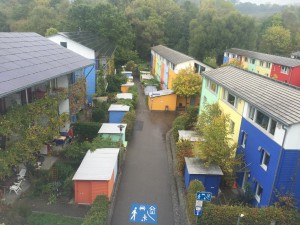Wantonly burning
carbon, Lufthansa flies us
home for Thursday class.
Tag Archives: Lecture
Getting on Board
On the morning of our last full day in Germany, we returned to Freiburg for tours of a variety of community led or inspired solar technology applications. After confusing the regular commuters on the bus (why were there so few seats and so many not-quite-awake Americans?) and again appreciating the efficiency of the regional train system, we met up with our morning guide. Hans-Jörg Schwander, a very tall bike enthusiast and president of the Innovation Academy board, led us via tram to the Schwartzwald-Stadion, where the Freiburg soccer team plays. It also happens to be the first international soccer stadium powered by solar panels. Jenille, one of our student commentators today, explained how it came to be: “Tickets were very popular, and solar panels were expensive, so they used a lottery scheme to get people to fund the solar panels, which gave them priority in getting season tickets.” “The seats were going to be sold regardless, so the SportClub proved there was enough demand that they could fund these solar panels through ticket sales, and used that asset. I’ve been so impressed by people being able to leverage things that already exist,” says Jeremy, today’s other interviewee. Though a little disappointing not to get onto the field, we were excited to see the team coming in for practice as we left the stadium and walked along the Dreisam river.
Hans and Professor Don Barber explained the various ways that the river, which had once been groomed into a straight and narrow channel to feed a hydropower plant, was being renatured. “Willows were planted to reduce bank erosion, rocks were placed to meander the river and oxygenate water for the fish,” said Jenille. “There are a lot of things you have to take into consideration – if there’s a lot of snow, then the water that comes down from the forest includes a lot of sedimentation, for example.” The river still leads to a hydropower station (currently closed for repairs), and runs through a park, with playgrounds and bike paths. Jeremy “loved the focus on biking, giving them the right of way, having that be the primary mode of transportation” that we have seen throughout our time here. He has also been struck by the children “riding tiny bikes on actual streets,” which feels like a different kind of learning opportunity than kids in the States have.
We picked up a different tram line, and returned to Vaubon, where we had visited the Oko-Institut on Thursday. We walked around the neighborhood, and Hans explained the planning of the community, where groups of people bought parcels of land and worked with architects to create sustainably-built homes and community gathering spaces. Jeremy told me that he was “happy to hear that there’s a very intentional process of seeking out communal opinions on things. Hans didn’t act like everything was perfect, though, because some people that live in the community are ‘black sheep’. I didn’t want it to be too glorified, if there are some issues, but I was happy to see community-based development thriving anyway.” Jenille found some echoes of classwork in this and the other intentional communities we visited over the course of our time here:
In Political Science, we’ve been talking about the bottom-up movement, and how culture influences peoples’ decisions. We’ve seen that a lot, over the past week, like in Wyhl. There are things that people decided, it’s very unified, and they aren’t waiting on the government. Togetherness and community came up in what Hans was talking about, with families sharing plots of land. It’s a family concept, not just your neighbor or your friend.
Our day ended with detailed looks at a couple of solar houses.
First, the Heliotrop, a house built by the architect who designed the Sonnenschiff (where the Oko-Institut is located), which revolves on its base to follow the sun. Jeremy was disappointed to learn that plans for Heliotrop Hotels haven’t gotten out of the planning stages, so keep your eyes out for his next entrepreneurial adventure. Then, we actually got to go into one of theEnergy Plus houses in the Sonnenschiff development, and speak with the owner of the house. “The whole concept is to reduce your consumption” observed Jeremy. When Jenille asked the homeowner what the advantages of living there were, she responded that it was the sense of community that meant the most to her. It doesn’t hurt that she earns about 3,600 euros annually from the solar energy she sells back to the grid.
We wrapped up the day with a conversation on a playground(college students are all about slides, I’ve learned) in the Sonnenschiff development, and said goodbye to Erhard, who gave us such a broad view of the different initiatives in and around Freiburg. As Jeremy and Jenille looked back over their time here, each noted that long term perspectives were particularly important to the work that has been done in the area. Jeremy “admired how the forest ranger said they make decisions on a 150 year cycle – that’s some forward thinking that is not in everyone’s culture.”
Tomorrow, we leave very early, taking a bus, a train, a train, a plane, a train, and a train back to campus. Of course, everyone will be very enthusiastic in Geology class on Thursday morning.
About our guest commentators:
Jeremy Graff Evans is a sophomore at Haverford College, likely majoring in Political Science, with minors in Environmental Studies and International Studies, but he’s not quite ready to put a label on anything yet. He was awakened to the threats to global stability of climate change through a high school course, and felt this 360 was an ideal way to explore the problem further, using the cluster to informer both personal and career decisions. He is on the basketball team at Haverford, and when not at practice, manages to find time to sing in the S Chords (an a capella group on campus), sit on the Committee for Environmental Responsibility and the Rufus Jones Leadership Institute Board, and work at the fitness center. All that, while spending most of his academic time at Bryn Mawr this semester.
Jenille Scott is a junior Biology major at Bryn Mawr College, originally from Jamaica. She plans to go into environmental law after graduation, and was excited to mix the science and politics (a true liberal arts perspective!) of Climate Change in this 360. Her list of campus commitments is long, and includes President of BACASO, supervisor at Erdman Dining Hall, and Green Ambassador.
Getting Philosophical (with Science Majors)
“Science is not the end of the story. It’s the beginning, really.” This is the through-line our two guest commentators, Jasmine and Nicole, found for today’s lectures in and around Freiburg. We began with an overview of Freiburg from a sustainable development perspective, given by our guide yesterday at the Innovation Academy, Steffen. Some of the Growth and Structure of Cities majors were particularly struck by his slides about the central train station, which is really constructed as a transportation hub. Regional trains, local trains, tram lines, and bus routes all converge there, but the complex also includes a bike parking building, and the car share garage. We also heard about the ways in which people are trying to teach children about recycling and sustainability, so that it will become ingrained (“and they’ll help influence their parents as well,” notes Jasmine).
We then hopped on a tram to Vauban, the neighborhood which used to house the French army barracks (until they left in 1992), and has since had a series of rejuvenation projects, aimed at increased sustainability. The Öko-Institut headquarters are in a zero-energy office building, which is part of a complex we’ll visit next week that includes many single-family homes and some apartments, as well as a supermarket and other office space.
The Institut was born out of the anti-nuclear protests in the mid-70s, and provided a space for anti-nuclear scientists to gather and publicize research. It “was privately funded at the beginning… it’s amazing that they were able to gather so much momentum even though they weren’t government funded. They were able to get so many citizens involved, so much support, and now they have all these contracts [across the EU for private companies and various governments] to do research and projects” explained Nicole.
“When we think about the United States, and especially the climate policy, it’s very political and very divisional,” she observed, so she asked the Institut’s co-founder Professor Doktor Rainer Grieshammer about lobbying done by the Institut or other groups on behalf of the Energiwende (energy transformation) cause. He shared that there isn’t a particular lobby group for these issues, they are just part of the general political conversation. Jasmine’s course last year with Prof. Hager about policy in Brazil, China, Germany, and the United States pointed to Chernobyl as a major uniting factor in German politics, which has been echoed by every conversation we’ve had with experts here in Freiburg.
Nicole has also found that “over the past couple of days we have talked a lot about spreading risk. The forest service doesn’t rely on one kind of tree, and a lot of the talks today embrace that idea as well. If the source diminishes, you need to be able to counteract that with something else.” Our afternoon meeting, with Andreas Markowsky, founder of the Ökostrom-Gruppe, gave students insight into a distinctly economic approach to the Energiewende: the company Andreas runs coordinates local investment in renewable energy generators. This means that when a wind farm or hydroplant is constructed in a town, individual citizens have the chance to invest financially in the technology, and earn returns based on the energy generation. “It’s not just sustainability from an ecological standpoint – it’s economic and social too. It’s interdisciplinary!” said Nicole.
 Check in again tomorrow for notes from our visit to a landfill-turned-residential community, and another research facility.
Check in again tomorrow for notes from our visit to a landfill-turned-residential community, and another research facility.
About our guest commentators:
Nicole Hamagami is a senior at Bryn Mawr College. She has been itching to participate in a 360, and was excited to look at the science of climate change from a variety of perspectives. As a Biology major, she learns a lot about scientific absolutes, and has appreciated the opportunities to explore some grey areas. She’s also a campus tour guide, and looks forward to sharing new insights on the Sustainability Tours she gives to prospective students.
Jasmine Rangel is a junior Chemistry major at Bryn Mawr College. She has always been interested in the energy side of chemistry, and a middle school teacher got her passionate about nature, but she was excited to learn more about how people react and respond to new technologies, science, and information in general. Jasmine is also a Traditions Mistress, so while we are in Germany, she’s in the midst of planning Lantern Night too (November 1 – get your lanterns ready!).







